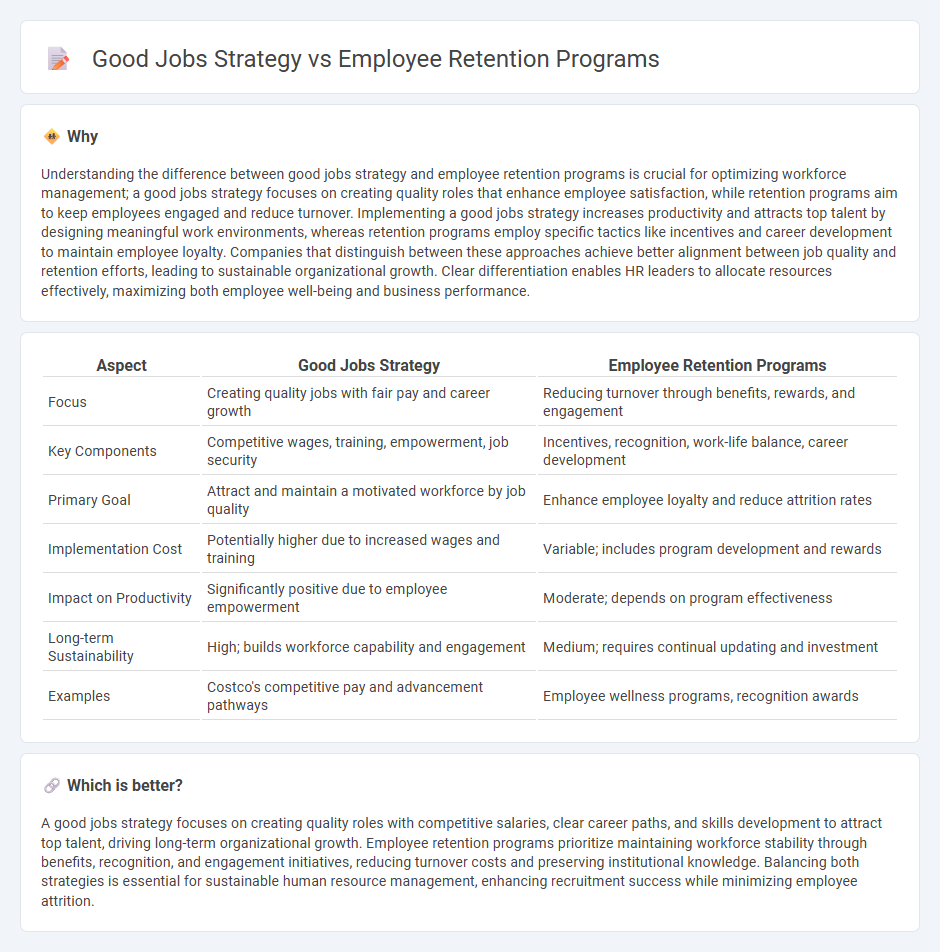
Effective human resources strategies balance competitive recruitment with robust employee retention programs to ensure organizational stability and growth. Emphasizing employee engagement, professional development, and workplace culture enhances job satisfaction and reduces turnover rates. Explore ways to optimize your HR approach by integrating job strategy and retention initiatives for sustained success.
Why it is important
Understanding the difference between good jobs strategy and employee retention programs is crucial for optimizing workforce management; a good jobs strategy focuses on creating quality roles that enhance employee satisfaction, while retention programs aim to keep employees engaged and reduce turnover. Implementing a good jobs strategy increases productivity and attracts top talent by designing meaningful work environments, whereas retention programs employ specific tactics like incentives and career development to maintain employee loyalty. Companies that distinguish between these approaches achieve better alignment between job quality and retention efforts, leading to sustainable organizational growth. Clear differentiation enables HR leaders to allocate resources effectively, maximizing both employee well-being and business performance.
Comparison Table
| Aspect | Good Jobs Strategy | Employee Retention Programs |
|---|---|---|
| Focus | Creating quality jobs with fair pay and career growth | Reducing turnover through benefits, rewards, and engagement |
| Key Components | Competitive wages, training, empowerment, job security | Incentives, recognition, work-life balance, career development |
| Primary Goal | Attract and maintain a motivated workforce by job quality | Enhance employee loyalty and reduce attrition rates |
| Implementation Cost | Potentially higher due to increased wages and training | Variable; includes program development and rewards |
| Impact on Productivity | Significantly positive due to employee empowerment | Moderate; depends on program effectiveness |
| Long-term Sustainability | High; builds workforce capability and engagement | Medium; requires continual updating and investment |
| Examples | Costco's competitive pay and advancement pathways | Employee wellness programs, recognition awards |
Which is better?
A good jobs strategy focuses on creating quality roles with competitive salaries, clear career paths, and skills development to attract top talent, driving long-term organizational growth. Employee retention programs prioritize maintaining workforce stability through benefits, recognition, and engagement initiatives, reducing turnover costs and preserving institutional knowledge. Balancing both strategies is essential for sustainable human resource management, enhancing recruitment success while minimizing employee attrition.
Connection
Effective job strategies align recruitment, development, and retention efforts to create a motivated workforce that drives organizational success. Employee retention programs reduce turnover by fostering job satisfaction, career growth, and workplace engagement, which are critical components of a robust jobs strategy. Integrating these elements enhances talent management, ensuring sustained productivity and a competitive advantage in Human Resources.
Key Terms
**Employee Retention Programs:**
Employee retention programs focus on strategies such as competitive compensation, professional development opportunities, and recognition initiatives to reduce turnover rates and enhance employee loyalty. These programs often include mentorship, wellness benefits, and clear career progression paths to foster a positive workplace culture and improve overall job satisfaction. Explore our comprehensive guide to understand how targeted retention strategies can transform your workforce stability.
Engagement
Employee retention programs emphasize structured initiatives such as recognition, rewards, and career development to boost engagement and reduce turnover. The good jobs strategy focuses on creating quality work environments with competitive wages, job security, and meaningful roles that naturally foster commitment. Explore the key differences and benefits of each approach to enhance workforce stability.
Recognition
Employee retention programs centered on recognition boost morale by rewarding achievements and fostering a positive work environment that encourages loyalty. Good jobs strategies integrate recognition as a core component to enhance job satisfaction, productivity, and employee engagement. Discover how effective recognition transforms retention and creates a thriving workplace culture.
Source and External Links
25 Employee Retention Strategies That Work - Highlights strategies like mentorship programs, regular feedback, career growth opportunities, positive culture, work-life balance, and employee recognition as key for retaining talent.
15 employee retention strategies to keep talent - Emphasizes building engagement, effective recognition and rewards, and recruiting employees who fit company culture as essential for employee retention.
18 Effective Employee Retention Strategies - Advises focusing on a robust hiring process, offering competitive salaries and benefits including flexible work arrangements, and investing in employee development as effective retention tactics.
 dowidth.com
dowidth.com